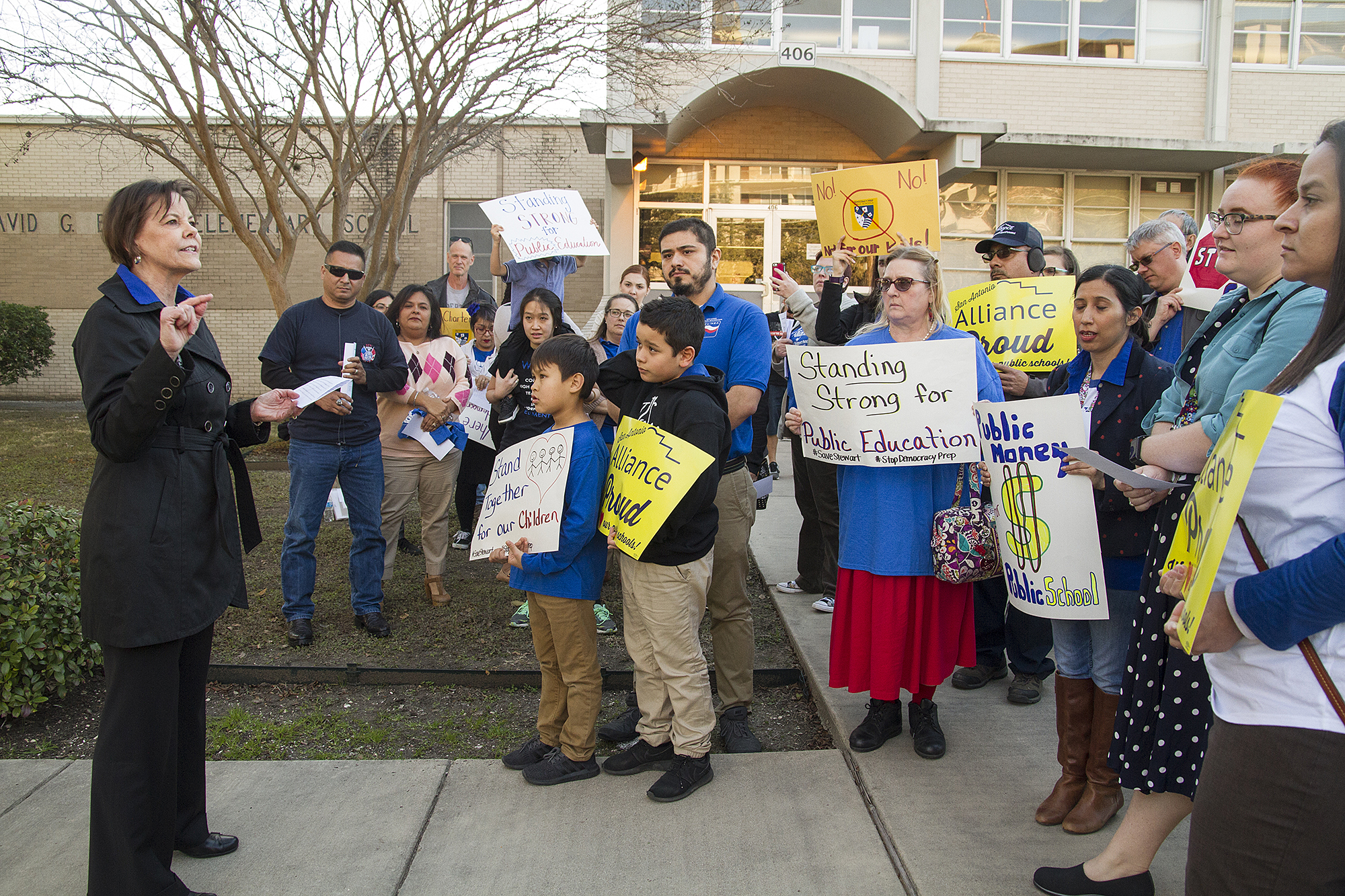
Photo by Alma Hernandez for Folo Media
“Whose schools?”
“Our schools!”
“Whose schools?”
“Our schools!”
That was the call and response chant on the steps of the SAISD administrative building ahead of the January 22 board meeting, in which the board voted to move forward in a charter agreement with Democracy Prep, a nonprofit organization that runs charter schools in Louisiana and the Northeast.
Following the Jan 22 meeting SAISD authorized Democracy Prep– which had not previously been approved to operate in Texas– to effect a school turnaround at Stewart Elementary, a traditional neighborhood school currently in its fifth year of failure to meet state standards. Authorized through SAISD, Democracy Prep can open more schools in Texas.
The 2017 law that incentivizes SAISD to contract with Democracy Prep, Senate Bill 1882, requires the school to serve every single child living in the Stewart attendance zone, if they chose to go there. What this means for special education and English language learners had not been fully worked out at the time of the January 22 meeting, but Martinez assured the board that it would be fully explored as the district hammered out a performance agreement and subsequent contract.
The Texas Education Agency had not finalized rules for SB 1882 in time for the February 20th board meeting. The district will check the terms of any partnership by those forthcoming rules before bringing the performance agreement to a vote. Final rules will be published by Feb 26, with guidance following on March 12, per the TEA website.
In the meantime, tension continues to build between the district and the union.
The San Antonio Alliance of Teachers and Support Personnel, the union representing faculty and non-administrative staff in the district, rallied ahead of the Jan 22 meeting to protest what they describe as the abdication of responsibility.
Later that night (once the decision was official) the Alliance Facebook page posted a summary of the meeting that ended with, “The district administration, in effect, admitted they do not know how to do their core mission of educating our district’s students and because of that they are bringing in a company from New York City to do the job that they are evidently not capable of doing.”
One of the Alliance’s concerns is what will happen to students who would not typically thrive on a Democracy Prep campus. Because of its history as an independent “no excuses” charter district, Democracy Prep schools have not operated under the same legal requirements to accommodate students considered part of “special populations.”
Democracy Prep was not on the agenda at the Feb 12 board meeting either, however Alliance president Shelley Potter presented an extensive list of performance recommendations to the board during the citizens to be heard portion of the meeting. Under the title, “What Our Community Demands from Any Proposed Charter School Operator in SAISD” the two page document lists six categories of detailed assurances the Alliance would like from the district, including transparent planning, high quality curriculum (including bilingual or dual language instruction), classroom management policy, and family supports. Two sections pertain to teacher and employee concerns.
Martinez has made his position known as well. In a January 24 interview with nonprofit news site The 74 Martinez noted that while the district has many choice schools, Democracy Prep is the first time he’s gotten backlash. He attributes this to the teacher contract issue.
“For every other option, the employees have reported to us, so we’ve been able to open new models with little resistance,” Martinez told The 74, “Is it coming from parents? The short answer is “no.” I had a parent meeting last week to explain this, and it’s not coming from them. I’m proud of the trust we have built with parents. Parents want these choices. The backlash is coming from our unions and alliances in San Antonio. It’s about having charter schools that don’t have union contracts versus schools with union contracts or union right.”

He went on to say that the district will choose partners who treat teachers well. While the details are not yet finalized, faculty contracts were non-negotiable for Democracy Prep, Martinez said, the charter school will be the employer, not SAISD. Teachers currently have protective contracts at SAISD, Democracy Prep practices at-will hiring. This came as an abrupt surprise for the faculty of Stewart.
During the Jan 22 board meeting, members of the Alliance spoke passionately to the board. Alejandra Lopez, a teacher at Stewart, accused the district of robbing the parents and faculty of their “right to self-determination.” Given the chance, she said, the parents would have participated in a redesign and used their voice.
As a matter of policy, the board does not respond to comments during the citizens to be heard. However, before the board voted to move forward with the arrangement, Martinez spoke to the issue of parental choice.
The parents of Stewart students have been advocating for their students for years, he said. The evidence is in the rapidly declining enrollment at Stewart as students have flocked to Brooks Academy and other nearby charter schools.
“Those parents do have a voice,” Martinez said, “They walk.”
Enrollment at Stewart has been falling for years. During the 2016-2017 school year, Stewart served 542 students. Enrollment had fallen from 560 the year before and 565 the year before that. Many of those students went to charter schools like nearby Brooks Academy.
I watched the attrition first hand when I was reporting for the Rivard Report.
In the spring of 2016, photographer Scott Ball and I followed three students at Stewart as a way to highlight the need and possibility for change under Martinez, who was then in his first year as superintendent. One of the first students we interviewed was a fourth-grader identified as a good student who needed strong supports to stay on track. His guardian told us that she had put him on the waiting list at Brooks Academy after talking to other parents who had done the same. While their chief concern was middle school, they wanted to start applying early so as not to miss their chance.
When we came back for a second interview, we were informed that the fourth-grader had left Stewart to attend Brooks Academy.
Data supports these parents’ decision. Brooks Academy may or may not be the best long-term decision, that data simply won’t exist until the school has been around longer. However, the data does support the decision to leave Stewart.
Mike Villarreal, a University of Texas at Austin researcher and former State representative, also spoke at the Jan 22 board meeting. Through a collaboration with the Texas Higher Education Coordinating Board, Texas Workforce Commission, and several local school districts, Villarreal has been able to trace graduates of various San Antonio area elementary schools into adulthood.
Long term student outcomes for Stewart were not good, Villarreal said. Even before Stewart had fallen out of compliance with state standards, it was graduating students into a future of low performance.
Stewart graduates who were in the workforce in 2016 made an average of $18,000 per year, Villarreal’s data showed. State average is $34,000. Only about five percent earned post-secondary certificates and degrees within six years of their projected high school graduation, compared to 20 percent statewide.
“I’m here to celebrate what you are already doing which is keeping your eye on student outcomes,” Villarreal said to the board.